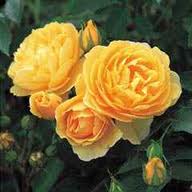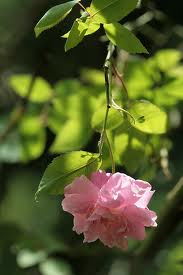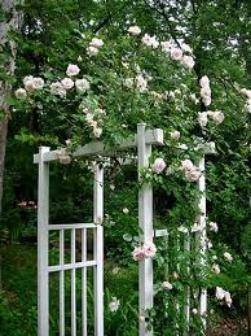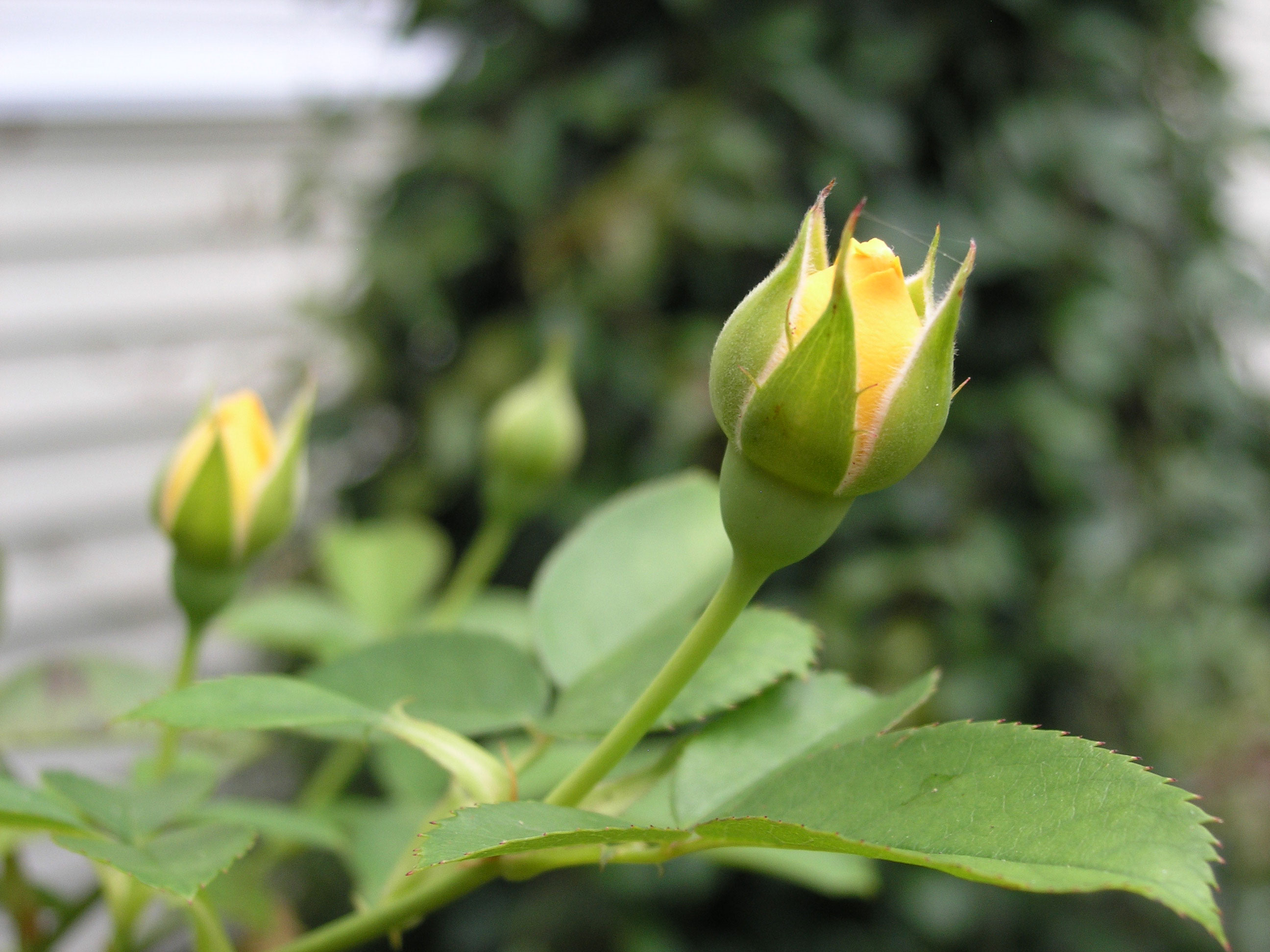With historical evidence of Tertiary fossils, experts can trace the wild rose back 5000 years. Roses, were inspiring enough to be in song and myth in Europe, Asia, and India as far back as 2000 B.C. when humans first intervened. Ancient trade records, archeological finds, and translations from Confucious confirm the first efforts at rose cultivation occurred in the Imperial gardens of the Chou dynasty in Peking around 500 B.C. Found there were 600 written volumes on the subject –including ancient drawings of Rosa laevigata, rugosa, banksiae, and odorata, the latter most certainly the most common one in the imperial gardens.
Other wild roses, about 150 species roses, have been identified and, of these more than half are indigenous to China and the mountain regions to its west. The rest are scattered in Europe, North America, and Africa. Many wild species contain the genetic legacy of many of the roses we see in gardens today.
 The Impact of Hybridization
The Impact of Hybridization
The genetically complex roses that lift our hearts today, however, have their ‘beginnings’ in the late 16th century with the birth of the business of hybridization. The old fashioned roses that we see in vintage pictures, R. alba, R. damascena, R. gallica officinalis, and, in particular, R. centifolia, the first known rose of 100 petals, inspired a virtual storm of crossbreeding. The mauves and purples of the gallica, the clear pink and Damask old rose fragrance of the damascena, the white to blush color and the fragrance of R. canina in the alba, and the voluptuous and fragrant centifolia, what we would think of as the classic English rose - the scents and the colors of these antique roses were combined with other species and amongst themselves.
And then, the studs from China arrived. One by one they arrived by ship in the Victorian Period – ‘Slater’s Crimson China’ (1792, ‘Parson’s Pink China’ (1793), Hume’s Blush Tea-scented China’(1809), and ‘Park’s Yellow Tea-scented China’ (1824), and with them, more cross-breeding. The marriage of the East to the West was consummated, and European hybridized roses were blessed with beautiful reds, the fragrance of a complex tea, and continuous and repeat flowering in the same season.
Enter the Old Fashioned Climbing Rose

The great roses of the 19th century literally took off in the garden. These were the roses popularized by the famous British garden designer and writer, Gertrude Jekyll. The arrival of the stud Chinas and crossbreeding with the damask and gallica gave birth to new classes of roses - the Portland roses, the highly scented, sensual and romantic (and reflowering!) Bourbons, and the strongly scented, delicately colored Teas. When crossbred with a China hybrid with R. moschata genes, the class of wonderful, rambunctious, musk-scented Noisettes came to be. And Noisettes, then fused with R. gigantean in the Teas, became the beautiful, scented, old fashioned climbing roses in the gardens of the period. And we have arrived. The first garden climbers.
Climbing just for the Sport of It
Since the time of beautiful Victorian gardens, roses have undergone many changes, with many new cultivars which combine genetic material for new scents, new and more intriguing color and growth habit. The color blue, except possibly for the rambler ‘Veilchenblau’ (1909) remains elusive. Hybridizers strive for longer flowering periods, less thorns, different scents. For the climbing rose, however, things just seemed to happen. First, we have the Noisette class of climbing roses – 19th century, delicate musk scented flowers, yet canes that can grow up to 20 feet.
Then in the 20th century, new crossbred Teas - Hybrid Teas – with their everblooming flowers of extraordinary color, and the new crossbred Floribundas – both shrub form, did something remarkable. Every now and then a Hybrid Tea or a Floribunda would stop acting like a bush and, unprompted, start lengthening its canes like, well, like a climber. These ‘sports’ were quickly seized and reproduced through seed for the public. Hence, we have a second group of climbers – those that look like a bush, have the same color and qualities of the bush it came from, but behave like a climber.
 The origin of a third group of climbing roses occurred when hybridizers turned to rambling roses, wild species roses with short flowering seasons and clusters of smaller flowers, but with other virtues. One was successfully bred in 1910, ‘Doctor W. Van Fleet’. However, the real pride and joy, was, once again by chance, its sport in 1930 – the famous ‘New Dawn’, the repeat flowering climber, the first of what rose breeders call the Modern Roses. It had it all – fragrance, continuous flowering, large blooms, manageable size, great color. Since then, ‘New Dawn’ has parented many other, including ‘Pink Perpetue’ and ‘Aloha’.
The origin of a third group of climbing roses occurred when hybridizers turned to rambling roses, wild species roses with short flowering seasons and clusters of smaller flowers, but with other virtues. One was successfully bred in 1910, ‘Doctor W. Van Fleet’. However, the real pride and joy, was, once again by chance, its sport in 1930 – the famous ‘New Dawn’, the repeat flowering climber, the first of what rose breeders call the Modern Roses. It had it all – fragrance, continuous flowering, large blooms, manageable size, great color. Since then, ‘New Dawn’ has parented many other, including ‘Pink Perpetue’ and ‘Aloha’.
Differences between Climbers and Ramblers
Now to the agile rose and its ability to ‘climb’. Roses are not really climbing plants as they have no method for attaching themselves, no tendrils, no suckers. The pseudo-ability to climb is attributed to their long runners, some quite vigorous. This large group of “runner” roses are almost all modern, a reflection of hybridizers keeping pace with society’s appetite for colorful, continuous flowering; though the varied genetic makeup makes classification difficult, two distinct groups called climbers and ramblers have emerged. They are categorized by differences in their upward and outward growth and their horticultural use.
Climbers
* Sturdy rigid, but not numerous canes with lateral stems of largish flowers
* Are less vigorous than ramblers.
* Often have large striking flowers with highly decorative color, dependable re-flowering on wood produced the same season, large clusters of blooms
* Somewhat graceless growth habit and sufficient but not dense foliage
* Generally need to be tied to a support such as a trellis or wall. Some called pillar roses are smaller than other climbers, and can grow without support in an upright or “pillar” position.
* The first modern climber was parented by a rambler (hmmm, there is a story here…)
* Often used to soften rigid lines, separate garden areas and create sense of spaciousness, outline and enhance entrances
Ramblers
* Ramblers have more relaxed, pliable stemming with clusters of smaller flowers
* Have rope-like canes that spread in all directions, can be trained onto a fence or trellis.
* Ramblers are prostrate by nature, include species such as R. luciae, R rugosa and Japan’s R. wichuaiana’, and the foundation of the modern procumbent cultivars.
* Ramblers are almost equally valued, being more adaptable, more discreet and more natural.
* Are mostly marked by a short flowering season with few exceptions, such as:
Turbat’s ‘Ghislaine de Feligonde’ (1916) FR
Bide’s ‘Phyllis Bide’ (1923)
* Create a softening effect, cover bare corners and unsightly areas, tumble down embankments,
Scramblers
 * Scramblers are the most vigorous and adventurous of the climbers and ramblers.
* Scramblers are the most vigorous and adventurous of the climbers and ramblers.
* Parent stock is from several species most notably the R. multiflora and R. moschata.
These are the tree climbers. Scramblers are the giants of the ramblers, climbing well in excess of 20 feet and nearly as wide. Examples are ‘Rambling Rector’ (the oldest), ‘Bobbie James’, and Hilda Murrell’s mega-giant ‘Kiftsgate’
Types of Structures for Climbers and Ramblers
In the words of Graham Stuart Thomas, the world’s pre-eminent rose gardener and the one credited with making old roses, once again, a gardening obsession, training is nice for climbing roses but “those of graceful growth do not reveal their greatest beauty and joy until one can contemplate the falling spray. Then and then only do these roses reveal their ultimate charm.”
Climbing roses are indeed beautiful and graceful when given the right support. And supports, which can be almost anything, also offer valuable architectural interest to your home and act as a focal point in the garden. Whatever you choose, it should take into account the material of the exterior of the house and be consistent with its architectural style. It should also be weather resistant and robust to support the weight of the climber.
The range of materials can be anything from structures of timber for substantial load bearing pergolas to wrought iron for railings and arches to brick piers. With the higher costs for material and labor these days to produce homemade structures, it makes sense to look at what is available in the marketplace. Either way, here are some tried and tested support structures for the garden climbers:
Arches and smaller Pergolas. The arch should be placed where it acts as a conduit between one part of the garden and another or at intervals along a path. It requires taller climbers for up and across. The pergola has parallel columns good for tie-in support. Recommendations are: ‘American Pillar’, ‘Blaze’, ‘New Dawn’, and ‘Zephirine Drouhin’.
“Well clothed” Pergolas.(as David Austin would say) – only ramblers have sufficient strength to cover the entire structure; they flower once a season. Recommendations: Banksiae, yellow or white mini rose blanket in spring; smaller but repeat flowering are any of the Karl Hetzel repeat ramblers that grow 10 – 11 ½ feet just over the structure, such as ‘Super Excelsa’
Trees and Shrubs. These are the only real choices for tree climbing scramblers such as ‘Kiftsgate’ and ‘Paul’s Himilayan Musk’. They are beautiful running up into the trees; if a shrub is used, pick a shrub size to partner with a rose of similar vigor.
Arbor. This can create an impressive entrance into the garden or patio. Sized right and continuous blooming choices are ‘Blaze’ and ‘Cecile Brunner’.
Trellis. This gives the rose the lift to spread up and out, fountainlike. Good choices are ‘American Pillar’ or, the fragrant long stemmed red ‘Don Juan’, or the lovely peony-like, myrrh scented ‘Constance Spry’.
Pillar. Selected climbers are termed ‘pillars’ and can eventually stand on their own, though a pole to tie into would be good. Can be made of timber, brick, stone, or a purchased structure of interlaced metal bars Pillars should be sunk 2 feet deep. Use 2 plants per pillar for coverage
Tripods. Tripods are excellent for the more awkward shrub roses and makes it possible to use climbers and ramblers within the shrubbery to good effect. Any size can be used with a given rose in mind.
Pavillions, Bowers, Gazebos. Recommendations: ‘Cecile Brunner’; or a mix of two such as, ‘Madame Gregoire Staechelin’ (1927) and ‘Cupid’(1915)
Homemade structures (fences, freestanding walls, etc). Use pressure treated lumber a minimum of 4 inches thick, sunk 2 feet into the ground. Any cross or lattice members should be 2 inches thick minimum.
Wall with espalier training structure. Space structure at least 1 inch from the wall for air circulation. Can be gorgeous with cascading climbers such as Don Juan’ and ‘Golden Showers’.
If the scent of roses wafting in the summer air appeals to you, be it that of old roses or the musk of Noisettes, or myrrh of ‘Constance Spry’, or even the apple scent of the Wichuraiana, it is time to take a look around. Perhaps a pergola to sit under in the early evening with a cool drink. Perhaps a pillar of scented color to walk near that welcomes your attention as you cut a few flowers to put in a vase. A beautiful summer is on the way. Enjoy!
PRUNING AND TRAINING CLIMBING ROSES
TIPS FOR PRUNING CLIMBERS
- When doing any pruning, use sharp, clean secateurs for a clean cut.
- Remove twiggy growth to help against disease like blackspot and to focus strength into the long climbing shoots for the first few years.
- Modern climbers with large flowers and climbing forms of antique roses (the Bourbons and Teas, for example) usually flower on side branches produced during the growing season, so the growth of those branches needs to be promoted. After the second year , prune back short side branches that have borne flowers to about 3 leaf buds for next year’s flowers, that is, prune to a ‘good eye’. The climber may have to be detached from its support to be pruned and then reattached, but it will be worth it. Do not touch the younger branches.
- Prune repeat bloomers in winter
- Climbers such as gallica, alba, and rugosa are sucker prone. Pull out suckers where they are attached to the root
- Bend vigorous shoots down to base of a neighboring bush and tuck under to maximize lateral flowers on the lower parts of the climber
- Remove spent wood of ‘once-flowering’ climbers with rambler stock immediately after flowering on all pillars and arches.
- In future years, gradually eliminate the main branches that have less productive growth to make room for the new vigorous growth.
TIPS FOR PRUNING RAMBLERS
- Don’t. These are the raucous and exuberant members of the rose family. Let them grow ‘without restriction’. Prune only if necessary for practical and aesthetic reasons- if canes are damaging one another, if the direction of growth is inconvenient, if part of the plant is poorly formed, etc.
- Do not deadhead, since they almost always produce colored hips that brighten up autumn. Some like Rosa banksiae actually flower better as their wood ages.
TRAINING CLIMBERS AND RAMBLERS
1. Rambler: 3 columns with heavy rope looped atop from one column to the next. Train branches to spiral around and up and around and up and then loop spiral around and across the rope
2. Rambler/ Climber: Plant at base of tripod leg. Loop canes around the legs, spiraling up to complete
3. Climber with rigid canes: Plant at base of pole or column. To the support, lasso half of canes around one side 1-2 ft from ground and lasso other half around the other side 2 -4 ft from ground.
4. Climber with flexible canes: Plant at base of support. Interweave the canes around and the support/column
5. To trellis: For optimum flowering, train canes horizontally on trellis by securing canes with soft ties.
6. To wall: Training a rose to a wall is easy. Pull the new shoots of the plant sideways and attach them to the wall supports so the growth habit of the rose moves horizontally as well as vertically. Fix branches to the support so that they form a fan; external branches should run in a direction almost horizontal to the ground so the flowering will take place in the lower areas which tend to lack coverage.
7. Tie in methods depend on the support structure used:
a. Walls: use parallel wires set at intervals of 18 inches and attached to vine eyes. Thread new growth behind and in front of the wires.
b. Trellises- same as walls, occasionally threading under the woodwork.
c. Other forms- tie with string or twine, loosely to allow stems to expand.
CULTIVATION AND FEEDING OF CLIMBING ROSES
Many climbing roses are generally hardier than other types of roses, thanks to their genetic legacy, but still have the many of the same cultivation requirements as do other roses.
- Time to purchase and plant. Bests are to purchase plant bare root or with roots in a preservative wrap in spring/early summer and to plant in autumn when it will focus its energy on root growth.
- Best climate. The best climate is anywhere but in extremes. Climate ideal where summer is not too hot, winter is not below 10 degrees F, rain is intermittent, and humidity is moderate.
- Sunlight. Best in full sun, but in warm dry summer areas half shade, protected by light branches of trees is good. Check the cultivar for tolerance to rain and wind; plant in a suitably protected spot for best flowering.
- Soil. The ideal pH is 6.0- 6.5; lime up or sulfur down accordingly. Loosen the soil in the hole 18 – 24 inches deep. Use a medium weight mix to replace or amend existing soil with 25% by volume organic matter. Peter Beales, world- class gardener with a world-class collection of roses notes, “Roses have a distinct preference for clay-based, heavier soils and… the more hybrid the cultivar the stronger the preference.” A bit of gypsum will improve the soil if too clayish. However, if lighter soils are the issue, take care to augment. Test your soil. Also talk with a local garden center specialist for proper soil amendments. Although the rugged chinensis, multifloras, and wichuraiana hybrids will put up with hardship, more delicate sports of the hybrid teas and floribundas will not, nor the shaped standards.
- Fertilizing. First, a planting hole well prepared will save a lot of time later. Soil test. Soils deficient in phosphorus and potassium especially should be amended with bone meal or superphosphate. The preferred timing for hole prep would be a season before actual planting, but this is not mandatory. If done properly, no further fertilizing is needed until the first flush of flowers is on the wane.
- Placement.
- Spread root around mounded soil in hole, lie to pitch at 11 o’clock toward the support structure.
- David Austin, creator of the English Rose and owner of one of Great Britian’s leading rose nurseries recommends that if staging a climber on a wall, place the rose plant 18 inches from the wall, roots pointing away from the wall. This helps roots reach fertile moist soil, not the impoverished stuff near the wall.
- The union of scion and stock should be planted just below the level of the ground
- Mulch. The primary functions of the mulch are to keep the soil moist and cool and to keep the weeds down. It will also, as David Austin says, “improve your roses out of all recognition.” The following are options for the mulch:
- 3-4 inch layer, no thicker, of well rotted manure or organic material such as bark shavings spread at base in spring after ground has warmed
- living prostrate plant ground cover around the plant base. Suggestions are Ajuga reptans bugleweed, Veronica repens prostrate speedwell, Brunnera macrophylla, periwinkle, Thymus praecox creeping thyme, and strawberries
- Watering. One inch of rainfall per week, or equivalent from the hose is adequate. If soil is sandy, water more; if clay, less is probably okay. Note: Roses do not like wet feet, so check the proposed planting site drainage before planting. Keep in mind, roses do need their water to bloom well.
- Feeding. [See #5 above first.] Roses are gross feeders and need to be fed well to flower.
- Sixteen nutrients are needed for plant growth, the most important of which need to be added regularly to the soil. These three are nitrogen, phosphorous, and potassium for cane/leaf, strong roots/flower production, and plant vigor respectively
- If soil was properly prepped (See #5), the first fertilizer treatment will be when first cycle of blooms fade.
- Feed again 2 months before expected frost date. If in a warm climate and trying for another cycle of blooms, you can wait a bit longer.
- Feed established rose bushes 3/annum- after pruning in early spring, just before first bloom, and then again 2 months before first fall frost . A monthly foliar feeding is okay as a supplement, but not necessary. If using a liquid fertilizers, more frequent feeding will be needed due to leaching of nutrients from the soil and plant take up.
- Slow acting bulky organic fertilizer (manure, compost, bonemeal, cottonseed meal) or fast acting inorganic fertilizer (chemical, potassium, ammonium nitrates, and ammonium phosphates available in granular or liquid forms. A combination of the 2 is ideal.
- Look for rose formulations or 5-10-5 for NP K in that order.


